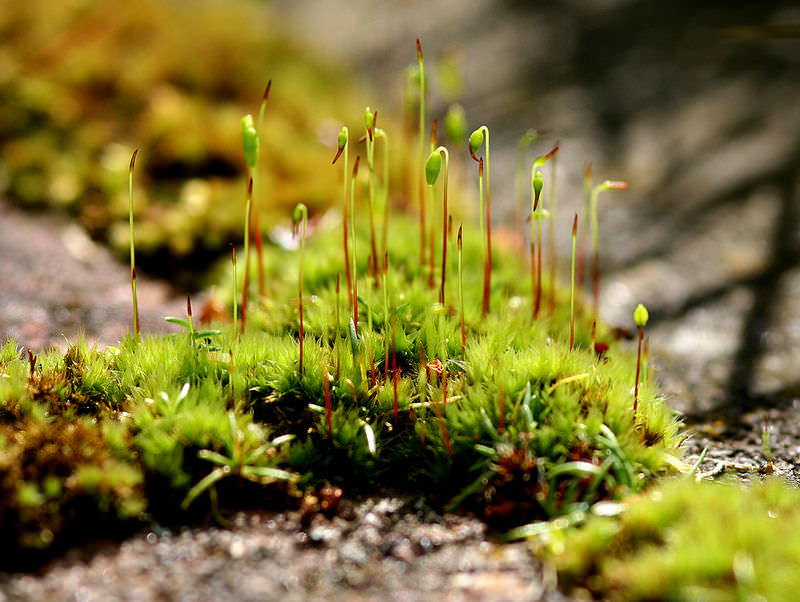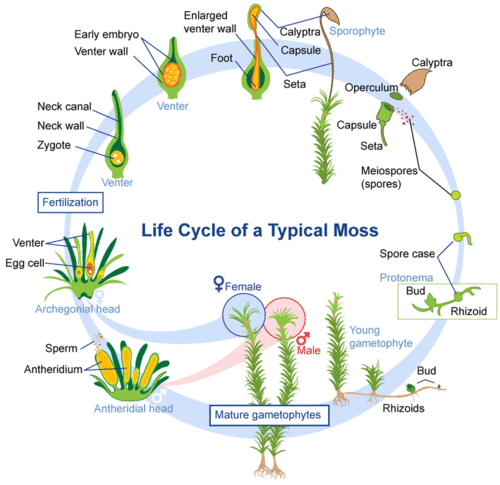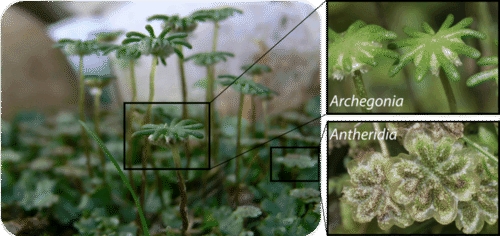9.9: Ciclo de Vida de Plantas No Vasculares
- Page ID
- 108335
\( \newcommand{\vecs}[1]{\overset { \scriptstyle \rightharpoonup} {\mathbf{#1}} } \)
\( \newcommand{\vecd}[1]{\overset{-\!-\!\rightharpoonup}{\vphantom{a}\smash {#1}}} \)
\( \newcommand{\dsum}{\displaystyle\sum\limits} \)
\( \newcommand{\dint}{\displaystyle\int\limits} \)
\( \newcommand{\dlim}{\displaystyle\lim\limits} \)
\( \newcommand{\id}{\mathrm{id}}\) \( \newcommand{\Span}{\mathrm{span}}\)
( \newcommand{\kernel}{\mathrm{null}\,}\) \( \newcommand{\range}{\mathrm{range}\,}\)
\( \newcommand{\RealPart}{\mathrm{Re}}\) \( \newcommand{\ImaginaryPart}{\mathrm{Im}}\)
\( \newcommand{\Argument}{\mathrm{Arg}}\) \( \newcommand{\norm}[1]{\| #1 \|}\)
\( \newcommand{\inner}[2]{\langle #1, #2 \rangle}\)
\( \newcommand{\Span}{\mathrm{span}}\)
\( \newcommand{\id}{\mathrm{id}}\)
\( \newcommand{\Span}{\mathrm{span}}\)
\( \newcommand{\kernel}{\mathrm{null}\,}\)
\( \newcommand{\range}{\mathrm{range}\,}\)
\( \newcommand{\RealPart}{\mathrm{Re}}\)
\( \newcommand{\ImaginaryPart}{\mathrm{Im}}\)
\( \newcommand{\Argument}{\mathrm{Arg}}\)
\( \newcommand{\norm}[1]{\| #1 \|}\)
\( \newcommand{\inner}[2]{\langle #1, #2 \rangle}\)
\( \newcommand{\Span}{\mathrm{span}}\) \( \newcommand{\AA}{\unicode[.8,0]{x212B}}\)
\( \newcommand{\vectorA}[1]{\vec{#1}} % arrow\)
\( \newcommand{\vectorAt}[1]{\vec{\text{#1}}} % arrow\)
\( \newcommand{\vectorB}[1]{\overset { \scriptstyle \rightharpoonup} {\mathbf{#1}} } \)
\( \newcommand{\vectorC}[1]{\textbf{#1}} \)
\( \newcommand{\vectorD}[1]{\overrightarrow{#1}} \)
\( \newcommand{\vectorDt}[1]{\overrightarrow{\text{#1}}} \)
\( \newcommand{\vectE}[1]{\overset{-\!-\!\rightharpoonup}{\vphantom{a}\smash{\mathbf {#1}}}} \)
\( \newcommand{\vecs}[1]{\overset { \scriptstyle \rightharpoonup} {\mathbf{#1}} } \)
\( \newcommand{\vecd}[1]{\overset{-\!-\!\rightharpoonup}{\vphantom{a}\smash {#1}}} \)
\(\newcommand{\avec}{\mathbf a}\) \(\newcommand{\bvec}{\mathbf b}\) \(\newcommand{\cvec}{\mathbf c}\) \(\newcommand{\dvec}{\mathbf d}\) \(\newcommand{\dtil}{\widetilde{\mathbf d}}\) \(\newcommand{\evec}{\mathbf e}\) \(\newcommand{\fvec}{\mathbf f}\) \(\newcommand{\nvec}{\mathbf n}\) \(\newcommand{\pvec}{\mathbf p}\) \(\newcommand{\qvec}{\mathbf q}\) \(\newcommand{\svec}{\mathbf s}\) \(\newcommand{\tvec}{\mathbf t}\) \(\newcommand{\uvec}{\mathbf u}\) \(\newcommand{\vvec}{\mathbf v}\) \(\newcommand{\wvec}{\mathbf w}\) \(\newcommand{\xvec}{\mathbf x}\) \(\newcommand{\yvec}{\mathbf y}\) \(\newcommand{\zvec}{\mathbf z}\) \(\newcommand{\rvec}{\mathbf r}\) \(\newcommand{\mvec}{\mathbf m}\) \(\newcommand{\zerovec}{\mathbf 0}\) \(\newcommand{\onevec}{\mathbf 1}\) \(\newcommand{\real}{\mathbb R}\) \(\newcommand{\twovec}[2]{\left[\begin{array}{r}#1 \\ #2 \end{array}\right]}\) \(\newcommand{\ctwovec}[2]{\left[\begin{array}{c}#1 \\ #2 \end{array}\right]}\) \(\newcommand{\threevec}[3]{\left[\begin{array}{r}#1 \\ #2 \\ #3 \end{array}\right]}\) \(\newcommand{\cthreevec}[3]{\left[\begin{array}{c}#1 \\ #2 \\ #3 \end{array}\right]}\) \(\newcommand{\fourvec}[4]{\left[\begin{array}{r}#1 \\ #2 \\ #3 \\ #4 \end{array}\right]}\) \(\newcommand{\cfourvec}[4]{\left[\begin{array}{c}#1 \\ #2 \\ #3 \\ #4 \end{array}\right]}\) \(\newcommand{\fivevec}[5]{\left[\begin{array}{r}#1 \\ #2 \\ #3 \\ #4 \\ #5 \\ \end{array}\right]}\) \(\newcommand{\cfivevec}[5]{\left[\begin{array}{c}#1 \\ #2 \\ #3 \\ #4 \\ #5 \\ \end{array}\right]}\) \(\newcommand{\mattwo}[4]{\left[\begin{array}{rr}#1 \amp #2 \\ #3 \amp #4 \\ \end{array}\right]}\) \(\newcommand{\laspan}[1]{\text{Span}\{#1\}}\) \(\newcommand{\bcal}{\cal B}\) \(\newcommand{\ccal}{\cal C}\) \(\newcommand{\scal}{\cal S}\) \(\newcommand{\wcal}{\cal W}\) \(\newcommand{\ecal}{\cal E}\) \(\newcommand{\coords}[2]{\left\{#1\right\}_{#2}}\) \(\newcommand{\gray}[1]{\color{gray}{#1}}\) \(\newcommand{\lgray}[1]{\color{lightgray}{#1}}\) \(\newcommand{\rank}{\operatorname{rank}}\) \(\newcommand{\row}{\text{Row}}\) \(\newcommand{\col}{\text{Col}}\) \(\renewcommand{\row}{\text{Row}}\) \(\newcommand{\nul}{\text{Nul}}\) \(\newcommand{\var}{\text{Var}}\) \(\newcommand{\corr}{\text{corr}}\) \(\newcommand{\len}[1]{\left|#1\right|}\) \(\newcommand{\bbar}{\overline{\bvec}}\) \(\newcommand{\bhat}{\widehat{\bvec}}\) \(\newcommand{\bperp}{\bvec^\perp}\) \(\newcommand{\xhat}{\widehat{\xvec}}\) \(\newcommand{\vhat}{\widehat{\vvec}}\) \(\newcommand{\uhat}{\widehat{\uvec}}\) \(\newcommand{\what}{\widehat{\wvec}}\) \(\newcommand{\Sighat}{\widehat{\Sigma}}\) \(\newcommand{\lt}{<}\) \(\newcommand{\gt}{>}\) \(\newcommand{\amp}{&}\) \(\definecolor{fillinmathshade}{gray}{0.9}\)
Haploides o diploides. ¿Cuál dirías que es dominante?
Eso puede depender de la planta. Comienza con musgo. La típica planta no vascular. Pero una planta tan simple tiene un ciclo de vida muy interesante. Mientras que la mayoría de los tipos de plantas tienen dos conjuntos de cromosomas en sus células vegetativas, los musgos tienen sólo un único conjunto de cromosomas. Entonces, ¿cómo ocurre la meiosis?
Ciclo de Vida de Plantas No Vasculares
Las plantas no vasculares incluyen musgos, hepáticas y hornworts. Son las únicas plantas con un ciclo de vida en el que la generación de gametofitos es dominante. La siguiente figura muestra el ciclo de vida del musgo. Las plantas familiares, verdes y fotosintéticas de musgo son gametofitos. La generación de esporófitos es muy pequeña y depende de la planta de gametofitos.
 Al igual que otras briofitas, las plantas de musgo pasan la mayor parte de su ciclo de vida como gametofitos. Encuentra el esporófito en el diagrama. ¿Ves cómo está creciendo en la planta de gametofitos?
Al igual que otras briofitas, las plantas de musgo pasan la mayor parte de su ciclo de vida como gametofitos. Encuentra el esporófito en el diagrama. ¿Ves cómo está creciendo en la planta de gametofitos? Los gametofitos de plantas no vasculares tienen distintos órganos reproductores masculinos o femeninos (ver Figura a continuación). Los órganos reproductores masculinos, llamados antheridia (singular, antheridium), producen espermatozoides móviles con dos flagelos. Los órganos reproductores femeninos, llamados archegonia (singular, archegonium), producen huevos.
 Los órganos reproductivos de briófitas como esta hepática son los anteridios masculinos y la archegonia femenina.
Los órganos reproductivos de briófitas como esta hepática son los anteridios masculinos y la archegonia femenina. Para que ocurra la fecundación, los espermatozoides deben nadar en una gota de agua desde un anteridio hasta un óvulo en un archegonio. Si se produce la fertilización, resulta en un cigoto que se convierte en un pequeño esporófito en la planta progenitora de gametofitos. El esporófito produce esporas haploides, y éstas se convierten en la siguiente generación de plantas de gametofitos. Entonces el ciclo se repite.
Resumen
- En las plantas no vasculares, la generación de gametofitos es dominante. El pequeño esporófito crece en la planta de gametofitos.
Revisar
- Describir la anteridia y la archegonia y sus funciones.
- Crea tu propio diagrama de ciclo para representar el ciclo de vida del musgo.
| Imagen | Referencia | Atribuciones |
 |
[Figura 1] | Crédito: Liverwort: Usuario:Lamiot/Wikimedia Commons; Archegonia y Antheridia: Hermann Schachner Fuente: Liverwort: commons.wikimedia.org/wiki/Archivo:Marchantia_Polymorphalamiot.448.jpg; Archegonia: commons.wikimedia.org/wiki/Archivo:Marchantia_polimorfa_%28b; _ 145318-481413% 29_3492.JPG; Antheridia: commons.wikimedia.org/wiki/Archivo:Marchantia_Polymorpha_%28C; _ 133318-471447% 29_4200.JPG Licencia: CC BY-NC |
 |
[Figura 2] | Crédito: Mariana Ruiz Villarreal (LadyOFHats) para Fundación CK-12 Fuente: Fundación CK-12 Licencia: CC BY-NC 3.0 |
 |
[Figura 3] | Crédito: Liverwort: Usuario:Lamiot/Wikimedia Commons; Archegonia y Antheridia: Hermann Schachner Fuente: Liverwort: commons.wikimedia.org/wiki/Archivo:Marchantia_Polymorphalamiot.448.jpg; Archegonia: commons.wikimedia.org/wiki/Archivo:Marchantia_polimorfa_%28b; _ 145318-481413% 29_3492.JPG; Antheridia: commons.wikimedia.org/wiki/Archivo:Marchantia_Polymorpha_%28C; _ 133318-471447% 29_4200.JPG Licencia: Liverwort: CC BY 3.0; Archegonia y Anteridia: Dominio público |

